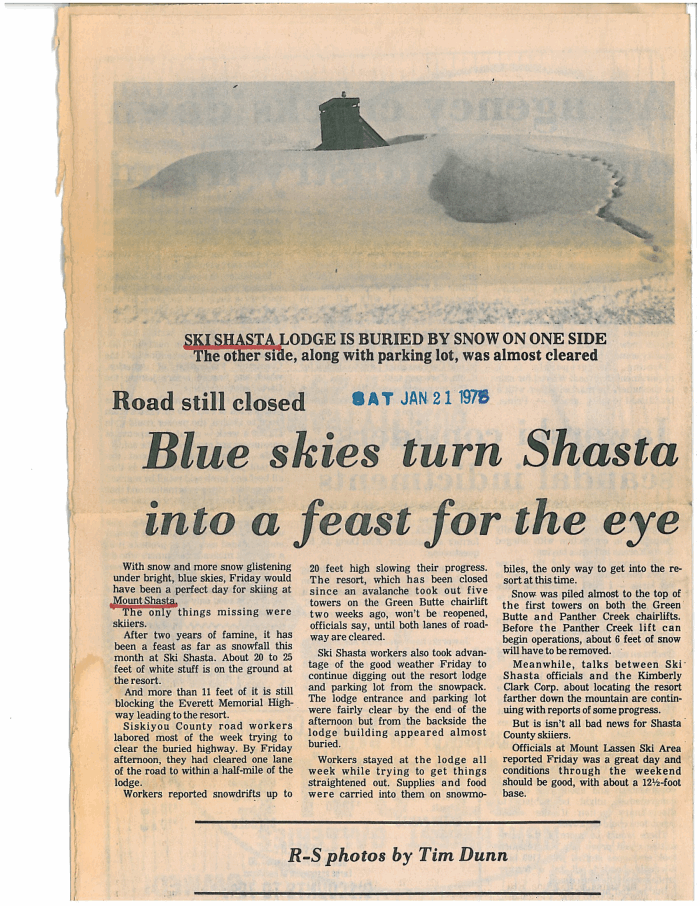In his 25 years of living in Mt. Shasta’s backyard, Chris Carr has never seen anything like it.
“It was remarkable. It nearly took my breath away,” said Carr, who owns Shasta Mountain Guides with his wife, Jenn.
Carr was on backcountry skis Sunday morning when he came upon a massive wall of snow just up from the Bunny Flat trailhead.
Carr and his crew monitor the mountain for conditions almost daily and he had heard reports of a potentially large avalanche.
“The most unique thing was how low that wall of snow was, much further down than anything I had ever experienced,” Carr said. “It was so startling how low it was and how big it was.”
Carr believes the avalanche in the wake of last week’s epic snowstorm was a 100-year event, Carr said.
It crashed a four-mile trail of destruction, falling 5,000 feet in elevation until it came to rest less than a mile up from the Bunny Flat trailhead, which is at an elevation of about 7,200 feet, Carr said.
The snow carved about a 300-foot-wide path in the terrain, ripping through trees while creating 30- to 40-foot walls, Carr said.
The snow piled up so high that Carr said you could ski down the walls.
On his website, Carr noted that it’s fortunate Everett Memorial Highway was closed when the avalanche occurred because there could have been people on the mountain. The highway accesses the Bunny Flat trailhead.
So how did this monster avalanche happen?
The mountain received a massive amount of snow last week — the city of Mount Shasta got 2 feet over a 24-hour period between last Tuesday and Wednesday — and then the weather warmed up, which dumped rain on top of the snow.
“When we have rain on top of snow, it’s almost like the perfect storm for these major avalanches,” Carr said, noting it creates an unstable “upside down snowpack.”
Monster avalanches have been documented on Mt. Shasta, but what is relatively uncommon is an avalanche of this size to dump down to such a low elevation, Carr said.
It probably last happened in the 1996, when another warm system blew into the region and rain fell on top of snow.
“This was significantly bigger than that,” Carr said.
Carr believes avalanches this big probably occurred during the 1980s, especially in some of the El Niño years.
The National Weather Service doesn’t track avalanches on Mt. Shasta, nor snowfall totals on the 14,162-foot mountain.
Emails sent Monday to the Mount Shasta Avalanche and Climbing Information center went unanswered. The center is staffed by U.S. Forest Service personnel and Monday was Presidents’ Day, a federal holiday.
Meanwhile, there is more than 12 feet of snow at the Old Ski Bowl on Mt. Shasta, the avalanche center said on its website.
An avalanche wiped out Ski Shasta at the Old Ski Bowl in 1978. Skiing didn’t return to the mountain until Mt. Shasta Ski Park opened in 1985.
On Monday, Mt. Shasta Ski Park had more than 10 feet of snow on top of its Douglas chairlift and about 3 feet of snow at is lodge, which sits at 5,500 feet.
If you’re thinking of going into the backcountry, Carr said to check the Mount Shasta Avalanche and Climbing Information center for its daily avalanche forecast.
Snow breaks trees Wednesday morning after 13 inches fell overnight in Redding. Jessica Skropanic, Record Searchlight
“That is something if you travel into the backcountry, you're ready every day,” Carr said.
There is a system coming into the area Tuesday night and Wednesday morning, but it will be nothing like what happened last week, said Misty Firmin, a meteorologist with the National Weather Service in Medford, Oregon.
Correction: An earlier version of this story said the avalanche buried the Sierra Club cabin at Horse Camp. The cabin sits under snow that has fallen to date this year.
THOUSANDS WERE TOPPLED: The Buzz: What happens to all those storm-ravaged trees after they're cleared?
4 FEET OF SNOW IN SHINGLETOWN: Mountain residents see no end in sight for power outages
HORSES GOT OUT IN TIME: Storm damages farm for rescued horses and 'broken children'
David Benda covers business, development and anything else that comes up for the USA TODAY Network in Redding. He’s part of a team of dedicated reporters that investigate wrongdoing, cover breaking news and tell other stories about your community. Reach him on Twitter @DavidBenda_RS or by phone at 1-530-225-8219. To support and sustain this work, please subscribe today.

No comments:
Post a Comment